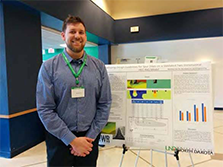Developing Design Guidelines for Spur Dikes in Curved Trapezoidal Channels based on a Validated Two-Dimensional HEC-RAS Model

Mathew Cox, a Master student of Science in Civil Engineering with a emphasis in Water Resources Engineering and Minor in Geography at University of North Dakota. Have Bachelor of Science in Civil Engineering from University of North Dakota. Research specialization: Hydraulic engineering, specifically in river systems.
Developing Design Guidelines for Spur Dikes in Curved Trapezoidal Channels based on a Validated Two-Dimensional HEC-RAS Model
Research Abstract
Spur dikes are a series of individual structures that are placed transverse to the flow, projecting from the riverbank with a horizontal crest. Spur dikes are designed either directed upstream, perpendicular to, or downstream of the river flow. Spur dikes that are perpendicular to the flow or angled downstream aim to deflect flow away from the bank. This allows for protection of the outside edge of a river bank. Spur dikes are often used on large rivers to increase channel depth and halt meander migration. Two-dimensional modeling allows for the real-world scenarios to be modeled with high accuracy, thus making them widely used in consulting engineering. This research will review the design guidelines for spur dikes used in rivers for the purpose of river bank protection from erosion. The importance of basing design guidelines from a two- dimensional model and validate the data with a physical model. The two-dimensional model will be set up within HEC-RAS 5.0.5. The physical model from the USBR will be used to verify the data developed from the HEC-RAS model. The guidelines developed will be of great use to North Dakota and the surrounding region.
Research Highlights
Spur dikes are commonly used as hydraulic structures to protect erodible bank areas. While spur dikes help protect the riverbank downstream, they change the flow pattern along the centerline of the channel, which can cause erosion and scour in previously stable locations. Historically, downscaled physical models were used to model channel sections for possibility of scour and erosion around hydraulic structures. The in-creased accuracy and efficiency of two-dimensional numerical models have allowed for numerical computer models to begin to take place of physical models. Numerical models are quicker to setup, simulate, and tweak than physical models. Instead of direct simulation of sediment transport using a numerical model, a relationship of maximum flow velocity, upstream flow velocity, and upstream Froude number was developed in this study to determine maximum scour depth. The developed relationship proved to be more accurate than the past relation-ships using the data from physical models. Further development of such relationships could allow for scour modeling of additional hydraulic structures.

Lim Yeo Howe
Civil Engineering
Upson Hall II Room 260D
243 Centennial Drive Stop 8115
Grand Forks, ND 58202-8115
Phone: 701-777-3998
Email: yeo.lim@und.edu


